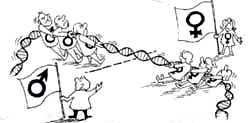New theory explains the evolution of sexes
 ACCORDING to the Book of Genesis in the Bible, God made Adam and then, not wanting him to feel lonely, took one of his ribs and created Eve. A simple explanation of why there are sexes and why there are only two. But try satisfying a scientist, or even a child, with that and you'll need to sound more convincing.
ACCORDING to the Book of Genesis in the Bible, God made Adam and then, not wanting him to feel lonely, took one of his ribs and created Eve. A simple explanation of why there are sexes and why there are only two. But try satisfying a scientist, or even a child, with that and you'll need to sound more convincing.
According to a new theory put forward by Oxford biologist Laurence Hurst, the two-sex evolution took place simply to keep the peace within cells during reproduction (Science, Vol 257 No 5068).
Hurst and his mentor William Hamilton argue binary sex developed out of the management of intra-genomic conflicts within cells. Traditionally, scientists believed the material within a cell work in harmony for common good during fusion, when genetic material in the nuclei and that in cytoplasmic organelles (specialised structures) like mitochondria (which contain enzymes for respiration and energy production) and chloroplasts (which contain chlorophyll) are brought together.
Hurst, however, sees organelles as selfish self-replicating entities. This means when nuclear DNA from each cell comes together into two pairs of chromosomes during fusion, there exists the risk of conflict between sets of organelles that have not joined up, and, the presence of a murderous mutant mitochondria or killer chloroplast could turn mating into chaos.
Hurst's model says sexes became essential to prevent the outbreak of such conflicts. One sex (male) disarms and surrenders its organelles, never passing them on to the next generation, leaving the other (female) to hand down its organelles. The two-sex characteristic -- a gene inducing male sacrifice to avoid a costly conflict and a gene that chooses mates of the opposite type to avoid two disarmers meeting and ending up with no organelles -- can soon be fixed in a population through evolutionary processes, says Hurst.
Genetic reproduction Organisms that reproduce differently -- by exchanging nuclear or genetic material -- don't require sexes. For instance, paramecia that exchange nuclei through a tiny hole have several mating types to avoid mating with close relatives but only one sex. They don't have to worry about cellular strife because organelles from separate cells are never thrown together.
Hurst cites the example of a certain species of hypothrich ciliates (a flattened ciliated protozoa) that reproduces both ways. During fusion, they appear to have two sexes, and when resorting to conjugatory sex, they have multiple mating types and only one sex.
There was, however, an exception to Hurst's thesis, which is backed by data from scientific literature: the 13-sex slime mould. The mould manages intra-genomic conflicts through a hierarchy in which a mould of a lower category yields to a higher one.
What is wrong with the 13-sex hierarchy, Hurst says, is "its inherent vulnerability to cheats -- what happens if one mutant set of mitochondria refuses to shut down?" As if to confirm his view, a molecular biologist from Tokyo University reported he had found a slime mould with mutant mitochondria that forced cells to accept mitochondria from both partners. While systems like these may evolve occasionally, they will inevitably develop into a binary system.
Foetal battle
Australian geneticist David Haig argues the genetic conflict continues in mammalian foetuses developing in the womb. He found the production of a gene in mice that induces cells to divide is driven by paternal DNA and hampered by maternal DNA.
Haig contends the paternal DNA tries to maximise the size of the foetus and ensure that it will grow strong and healthy to perpetuate the father's genes whereas the maternal DNA tries to safeguard the mother's health to ensure that future offsprings also survive, thus enabling more copies of the mother's genes.
Haig says a big and heavy birth means the mother has less resources to fight disease and to take care of future siblings.
